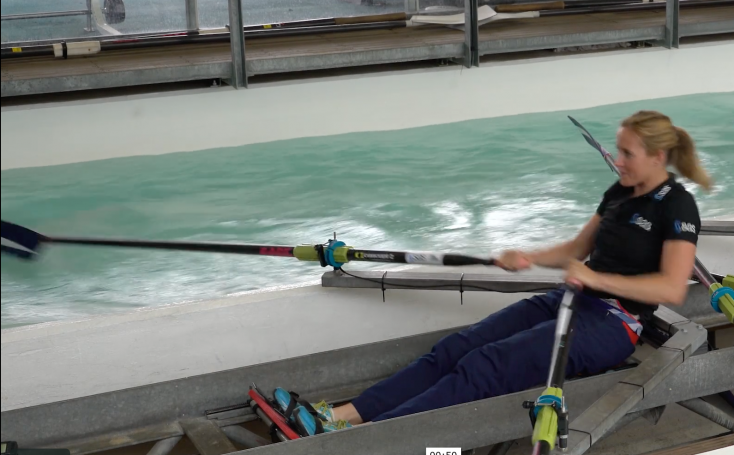Although often thought of as a “pulling” sport, in fact, rowing is much more dependent on the “pushing” forces of a rower’s legs. To demonstrate this, SAS, the Official Analytics Partner of British Rowing, invited double Olympic champion Helen Glover to row in an indoor practice tank rigged with sensors on the oars and footplates. As Glover was rowing, SAS collected and analysed data to visually illustrate each stroke and show there is always an opportunity to improve performance, even at the elite level, by highlighting inconsistencies, strengths and weaknesses.
 Helen Glover rowing in the tank at Royal Albert Dock, London [click to view]
Helen Glover rowing in the tank at Royal Albert Dock, London [click to view]
Data insights from sculling force curves
The SAS Institute kindly provided additional insights by giving us summaries of the force curves taken from the bowside and strokeside oarlocks. (I’m guessing Port and Starboard on the images as P and S).
These compare “David Smith” – presumably a local athlete – with Helen Glover – presumably the “Olympic Athlete” in the key.
Gate force against gate angle
This first graph shows David in blue against the Olympian in gold plotting Gate force vertically against Gate angle horizontally.
Apart from the obvious consistency delivered by Helen compared to David, the main insight I take from this is from the lefthand side image where you can see the blue plot has a lot more dots on the right (around the finish) than the gold. This is typical of beginners who carry on holding the oars under the water and often leaning back as well while not actually continuing to accelerate the oar in the water.
 Gate force plot for sculling
Gate force plot for sculling
An easy way to help athletes see they’re doing this is to loose the shoe straps so their feet come away from the foot stretcher and then tell them to time the extraction based on this – tap out the finish when your feet get disconnected.
Gate angle against gate angle velocity
The next graph shows the acceleration of the movement of the oarlock against the angle of the oarlock. Here, again there’s a longer stroke on both P and S for the Olympian and the same front-end loading for the Olympian compared to back-end for David. Helen has a little wobble on the recovery on her port side where the dots diverge (may be rigged too low?) but the power phase consistency of dot overlay is impressive.
 Gate angle velocity rowing force graph
Gate angle velocity rowing force graph
If I were coaching David I would get him to row with less power and focus on consistency – maybe adding straws to mark his catch entry reach and also figure out how to stop him flailing around less at the finish – why does his plot go above the power horizontal line that Helen Glover lays down? This is were actually watching the athlete gives more coaching insight than the data alone. I wouldn’t want to guess what he is doing with the handles / gates just from this graph.
Using RP3 analysis
The RP3 software has in-built analysis based on the interface which receives a signal from 4 magnets embedded in the flywheel – each time one passes over the Hall Sensor, it sends a pulse to the software and from this your force curve can be interpreted by the RP3 Rowing App.
The principles are similar, but cheaper and more accessible than the instrumented force gates used above. The app is a free download in the google play store. Here is how to understand power curves.
Thames Tradesmen’s Rowing Club tested the RP3 in July 2017 and they said
I got some of my rowers onto the [RP3] machine this weekend. The data you can get from it is amazing!
I think the club having at least one machine would really help improve people’s efficiency and effectiveness.







This Post Has 4 Comments
Hi Rebecca,
This is a really interesting article – but it looks like the rigging may be off for “Dave Smith” – surely having 25 degrees more angle at the finish is a calibration error or rigging problem rather than technique?
Kind regards,
Nick Thorn
Nick – thanks for this. Since they were both rowing in the rowing tank at the London Docks I guess they were using the same seat and instrumented oarlocks. My suspicion is that it’s more inexperience likely than rig! Rebecca
Hi Rebecca,
Fascinating stuff and Helen’s angles and power curves are so consistent.
I have a C2 so can get one dimensional power curves to some extent but not sculling differentials of power/angles for bow/stroke-side. I’m a long time (G) bowside sweep rower and late to sculling. I think I am finding my right leg is dominant (common apparently) and seems to make getting a stable start demanding and troublesome (assuming the rest of my technique is perfect!!??)
Is this Docklands tank setup/service permanent and open to the rowing public to get the same analysis.
I’d be interested – a useful investment (if it’s not bankrupting!!)
If not, any other options, e.g. Dr Kleshnev, BioRower?
Many thanks,
Graham